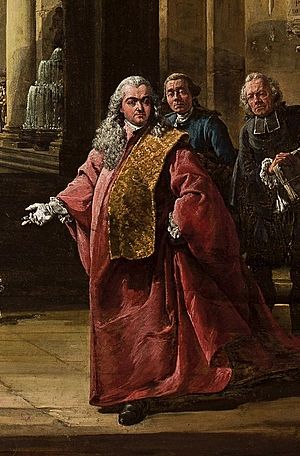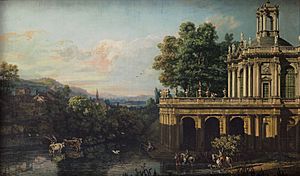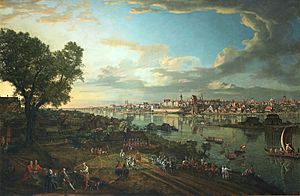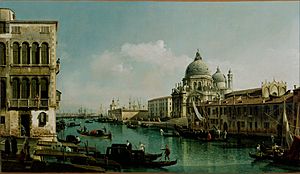Bernardo Bellotto facts for kids
Quick facts for kids
Bernardo Bellotto
|
|
|---|---|

Detail of Self-portrait as Venetian ambassador (c. 1765)
|
|
| Born | 30 January 1721 |
| Died | 17 November 1780 |
| Resting place | Capuchin Church, Warsaw, Poland |
| Nationality | Venetian |
| Known for | Landscape painting |
|
Notable work
|
View of Warsaw from Praga, Dresden From the Right Bank of the Elbe Above the Augustus Bridge |
| Patron(s) | Stanislaus II Augustus |
Bernardo Bellotto (born January 30, 1721 – died November 17, 1780) was a famous Italian painter. He was known for his detailed paintings of cities, especially in Europe. These types of paintings are called vedute (say: veh-DOO-tay), which means "views." He also made prints using a technique called etching.
Bellotto painted many cities like Dresden, Vienna, Turin, and Warsaw. He was the student and nephew of another very famous painter, Canaletto. Sometimes, Bellotto even signed his paintings using his uncle's name, "Canaletto." This caused some confusion! However, Bellotto's paintings often used darker colors than his uncle's. He also painted clouds and shadows in a way that reminded people of Dutch paintings.
Bellotto's style was special because he showed buildings and nature in great detail. He was also very good at capturing the unique light of each place. It's possible that Bellotto, and other Venetian artists who painted city views, used a device called a camera obscura. This early camera-like tool helped them draw city scenes with amazing accuracy.
Life of Bernardo Bellotto

Bernardo Bellotto was born in Venice, a beautiful city in Italy. His mother, Fiorenza Canal, was the sister of the famous painter Canaletto. Bernardo learned to paint in his uncle's art studio.
In 1742, he moved to Rome and painted views of that ancient city. He traveled around northern Italy in 1744 and 1745. During these trips, he painted many more city scenes. He even worked for important rulers like Charles Emmanuel III of Savoy.
From 1747 to 1758, Bellotto lived in Dresden, Germany. He was invited there by King Augustus III of Poland. He painted many pictures of Dresden and the nearby town of Pirna. Today, these paintings are very important. They show us what Dresden looked like before much of it was destroyed during World War II.
Bellotto became well-known internationally. In 1758, Empress Maria Theresa invited him to Vienna, Austria. There, he painted beautiful views of the city's famous buildings.
In 1761, Bellotto went to Munich, Germany, and stayed for almost a year. Empress Maria Theresa had praised his art, so the rulers of Bavaria asked him to paint for them. He created a wide view of Munich and two paintings of Nymphenburg Palace. By the end of 1761, Bellotto returned to Dresden.

In 1763, King Augustus III of Poland died. Bellotto's work in Dresden became less important. So, he decided to look for a new job in Saint Petersburg, Russia, at the court of Catherine II of Russia.
However, on his way to Russia, he received an invitation in 1764. Poland's new King, Stanislaus Augustus Poniatowski, asked Bellotto to be his court painter in Warsaw. Bellotto accepted and moved to Warsaw in 1768.
Bellotto stayed in Warsaw for about 16 years, for the rest of his life. He painted many views of the Polish capital and its surroundings for the Royal Castle. These paintings were part of a larger project by the King to decorate the castle.
In 1769, Bellotto and his son Lorenzo (who was also a painter) completed another big project for the King. They painted fourteen views of Rome, both ancient and papal. These paintings were based on famous etchings by Giovanni Battista Piranesi. Today, these Roman views are in different museums, mostly in Russia.
Bellotto's paintings of Warsaw are very special. He painted 26 vedute between 1770 and 1780 for a room in the Royal Castle. After World War II, when Warsaw was almost completely destroyed, these paintings were used to help rebuild the city exactly as it was. They were like a detailed map of the old city.
Bellotto's early paintings looked a lot like his uncle's work. But as he got older, his style became more unique. He was inspired by Dutch landscape paintings, using lots of clouds, shadows, and rich green trees. His colors were often cooler, with a lot of steely gray.
Later in his life, Bellotto's paintings changed again. He focused more on what he saw right in front of him. He became better at capturing the feeling of a place. His paintings also became more colorful and used warmer tones. For the first time, he also painted historical events, like Election of Stanislaus Augustus (1778).
Bernardo Bellotto died in Warsaw in 1780. He was buried in the Capuchin Church on Miodowa Street.
|
See also
 In Spanish: Bernardo Bellotto para niños
In Spanish: Bernardo Bellotto para niños




